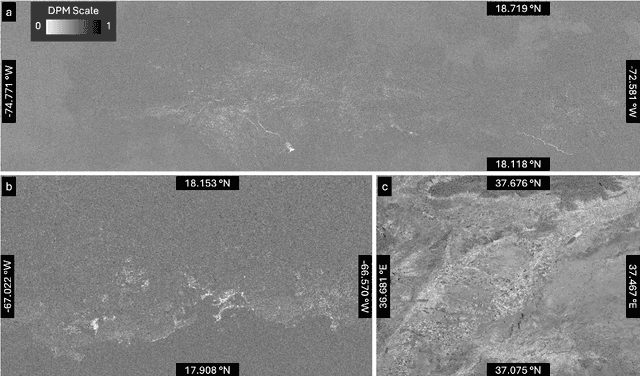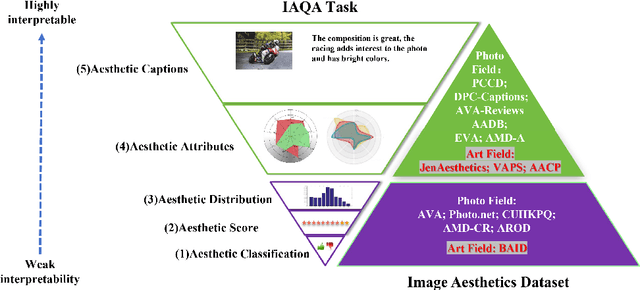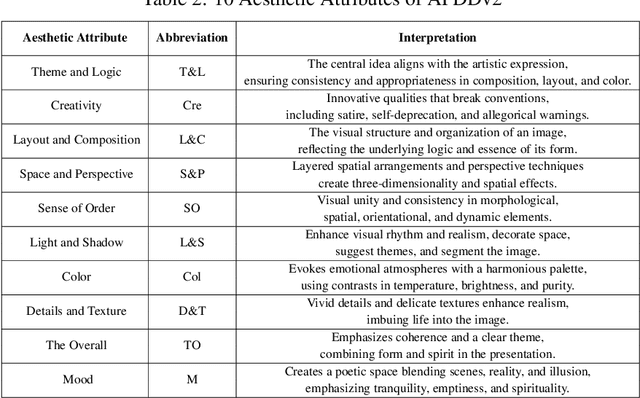Shan Gao
In vivo 3D ultrasound computed tomography of musculoskeletal tissues with generative neural physics
Aug 17, 2025Abstract:Ultrasound computed tomography (USCT) is a radiation-free, high-resolution modality but remains limited for musculoskeletal imaging due to conventional ray-based reconstructions that neglect strong scattering. We propose a generative neural physics framework that couples generative networks with physics-informed neural simulation for fast, high-fidelity 3D USCT. By learning a compact surrogate of ultrasonic wave propagation from only dozens of cross-modality images, our method merges the accuracy of wave modeling with the efficiency and stability of deep learning. This enables accurate quantitative imaging of in vivo musculoskeletal tissues, producing spatial maps of acoustic properties beyond reflection-mode images. On synthetic and in vivo data (breast, arm, leg), we reconstruct 3D maps of tissue parameters in under ten minutes, with sensitivity to biomechanical properties in muscle and bone and resolution comparable to MRI. By overcoming computational bottlenecks in strongly scattering regimes, this approach advances USCT toward routine clinical assessment of musculoskeletal disease.
Spatially-Heterogeneous Causal Bayesian Networks for Seismic Multi-Hazard Estimation: A Variational Approach with Gaussian Processes and Normalizing Flows
Apr 05, 2025



Abstract:Post-earthquake hazard and impact estimation are critical for effective disaster response, yet current approaches face significant limitations. Traditional models employ fixed parameters regardless of geographical context, misrepresenting how seismic effects vary across diverse landscapes, while remote sensing technologies struggle to distinguish between co-located hazards. We address these challenges with a spatially-aware causal Bayesian network that decouples co-located hazards by modeling their causal relationships with location-specific parameters. Our framework integrates sensing observations, latent variables, and spatial heterogeneity through a novel combination of Gaussian Processes with normalizing flows, enabling us to capture how same earthquake produces different effects across varied geological and topographical features. Evaluations across three earthquakes demonstrate Spatial-VCBN achieves Area Under the Curve (AUC) improvements of up to 35.2% over existing methods. These results highlight the critical importance of modeling spatial heterogeneity in causal mechanisms for accurate disaster assessment, with direct implications for improving emergency response resource allocation.
Multi-resolution Score-Based Variational Graphical Diffusion for Causal Disaster System Modeling and Inference
Apr 05, 2025Abstract:Complex systems with intricate causal dependencies challenge accurate prediction. Effective modeling requires precise physical process representation, integration of interdependent factors, and incorporation of multi-resolution observational data. These systems manifest in both static scenarios with instantaneous causal chains and temporal scenarios with evolving dynamics, complicating modeling efforts. Current methods struggle to simultaneously handle varying resolutions, capture physical relationships, model causal dependencies, and incorporate temporal dynamics, especially with inconsistently sampled data from diverse sources. We introduce Temporal-SVGDM: Score-based Variational Graphical Diffusion Model for Multi-resolution observations. Our framework constructs individual SDEs for each variable at its native resolution, then couples these SDEs through a causal score mechanism where parent nodes inform child nodes' evolution. This enables unified modeling of both immediate causal effects in static scenarios and evolving dependencies in temporal scenarios. In temporal models, state representations are processed through a sequence prediction model to predict future states based on historical patterns and causal relationships. Experiments on real-world datasets demonstrate improved prediction accuracy and causal understanding compared to existing methods, with robust performance under varying levels of background knowledge. Our model exhibits graceful degradation across different disaster types, successfully handling both static earthquake scenarios and temporal hurricane and wildfire scenarios, while maintaining superior performance even with limited data.
TextCrafter: Accurately Rendering Multiple Texts in Complex Visual Scenes
Apr 01, 2025Abstract:This paper explores the task of Complex Visual Text Generation (CVTG), which centers on generating intricate textual content distributed across diverse regions within visual images. In CVTG, image generation models often rendering distorted and blurred visual text or missing some visual text. To tackle these challenges, we propose TextCrafter, a novel multi-visual text rendering method. TextCrafter employs a progressive strategy to decompose complex visual text into distinct components while ensuring robust alignment between textual content and its visual carrier. Additionally, it incorporates a token focus enhancement mechanism to amplify the prominence of visual text during the generation process. TextCrafter effectively addresses key challenges in CVTG tasks, such as text confusion, omissions, and blurriness. Moreover, we present a new benchmark dataset, CVTG-2K, tailored to rigorously evaluate the performance of generative models on CVTG tasks. Extensive experiments demonstrate that our method surpasses state-of-the-art approaches.
Segment Any-Quality Images with Generative Latent Space Enhancement
Mar 16, 2025



Abstract:Despite their success, Segment Anything Models (SAMs) experience significant performance drops on severely degraded, low-quality images, limiting their effectiveness in real-world scenarios. To address this, we propose GleSAM, which utilizes Generative Latent space Enhancement to boost robustness on low-quality images, thus enabling generalization across various image qualities. Specifically, we adapt the concept of latent diffusion to SAM-based segmentation frameworks and perform the generative diffusion process in the latent space of SAM to reconstruct high-quality representation, thereby improving segmentation. Additionally, we introduce two techniques to improve compatibility between the pre-trained diffusion model and the segmentation framework. Our method can be applied to pre-trained SAM and SAM2 with only minimal additional learnable parameters, allowing for efficient optimization. We also construct the LQSeg dataset with a greater diversity of degradation types and levels for training and evaluating the model. Extensive experiments demonstrate that GleSAM significantly improves segmentation robustness on complex degradations while maintaining generalization to clear images. Furthermore, GleSAM also performs well on unseen degradations, underscoring the versatility of our approach and dataset.
Less is More: On the Importance of Data Quality for Unit Test Generation
Feb 20, 2025Abstract:Unit testing is crucial for software development and maintenance. Effective unit testing ensures and improves software quality, but writing unit tests is time-consuming and labor-intensive. Recent studies have proposed deep learning (DL) techniques or large language models (LLMs) to automate unit test generation. These models are usually trained or fine-tuned on large-scale datasets. Despite growing awareness of the importance of data quality, there has been limited research on the quality of datasets used for test generation. To bridge this gap, we systematically examine the impact of noise on the performance of learning-based test generation models. We first apply the open card sorting method to analyze the most popular and largest test generation dataset, Methods2Test, to categorize eight distinct types of noise. Further, we conduct detailed interviews with 17 domain experts to validate and assess the importance, reasonableness, and correctness of the noise taxonomy. Then, we propose CleanTest, an automated noise-cleaning framework designed to improve the quality of test generation datasets. CleanTest comprises three filters: a rule-based syntax filter, a rule-based relevance filter, and a model-based coverage filter. To evaluate its effectiveness, we apply CleanTest on two widely-used test generation datasets, i.e., Methods2Test and Atlas. Our findings indicate that 43.52% and 29.65% of datasets contain noise, highlighting its prevalence. Finally, we conduct comparative experiments using four LLMs (i.e., CodeBERT, AthenaTest, StarCoder, and CodeLlama7B) to assess the impact of noise on test generation performance. The results show that filtering noise positively influences the test generation ability of the models.
Challenges and recommendations for Electronic Health Records data extraction and preparation for dynamic prediction modelling in hospitalized patients -- a practical guide
Jan 17, 2025Abstract:Dynamic predictive modeling using electronic health record (EHR) data has gained significant attention in recent years. The reliability and trustworthiness of such models depend heavily on the quality of the underlying data, which is largely determined by the stages preceding the model development: data extraction from EHR systems and data preparation. We list over forty challenges encountered during these stages and provide actionable recommendations for addressing them. These challenges are organized into four categories: cohort definition, outcome definition, feature engineering, and data cleaning. This list is designed to serve as a practical guide for data extraction engineers and researchers, supporting better practices and improving the quality and real-world applicability of dynamic prediction models in clinical settings.
Stability and List-Replicability for Agnostic Learners
Jan 09, 2025Abstract:Two seminal papers--Alon, Livni, Malliaris, Moran (STOC 2019) and Bun, Livni, and Moran (FOCS 2020)--established the equivalence between online learnability and globally stable PAC learnability in binary classification. However, Chase, Chornomaz, Moran, and Yehudayoff (STOC 2024) recently showed that this equivalence does not hold in the agnostic setting. Specifically, they proved that in the agnostic setting, only finite hypothesis classes are globally stable learnable. Therefore, agnostic global stability is too restrictive to capture interesting hypothesis classes. To address this limitation, Chase \emph{et al.} introduced two relaxations of agnostic global stability. In this paper, we characterize the classes that are learnable under their proposed relaxed conditions, resolving the two open problems raised in their work. First, we prove that in the setting where the stability parameter can depend on the excess error (the gap between the learner's error and the best achievable error by the hypothesis class), agnostic stability is fully characterized by the Littlestone dimension. Consequently, as in the realizable case, this form of learnability is equivalent to online learnability. As part of the proof of this theorem, we strengthen the celebrated result of Bun et al. by showing that classes with infinite Littlestone dimension are not stably PAC learnable, even if we allow the stability parameter to depend on the excess error. For the second relaxation proposed by Chase et al., we prove that only finite hypothesis classes are globally stable learnable even if we restrict the agnostic setting to distributions with small population loss.
The Prompt Alchemist: Automated LLM-Tailored Prompt Optimization for Test Case Generation
Jan 02, 2025



Abstract:Test cases are essential for validating the reliability and quality of software applications. Recent studies have demonstrated the capability of Large Language Models (LLMs) to generate useful test cases for given source code. However, the existing work primarily relies on human-written plain prompts, which often leads to suboptimal results since the performance of LLMs can be highly influenced by the prompts. Moreover, these approaches use the same prompt for all LLMs, overlooking the fact that different LLMs might be best suited to different prompts. Given the wide variety of possible prompt formulations, automatically discovering the optimal prompt for each LLM presents a significant challenge. Although there are methods on automated prompt optimization in the natural language processing field, they are hard to produce effective prompts for the test case generation task. First, the methods iteratively optimize prompts by simply combining and mutating existing ones without proper guidance, resulting in prompts that lack diversity and tend to repeat the same errors in the generated test cases. Second, the prompts are generally lack of domain contextual knowledge, limiting LLMs' performance in the task.
APDDv2: Aesthetics of Paintings and Drawings Dataset with Artist Labeled Scores and Comments
Nov 13, 2024



Abstract:Datasets play a pivotal role in training visual models, facilitating the development of abstract understandings of visual features through diverse image samples and multidimensional attributes. However, in the realm of aesthetic evaluation of artistic images, datasets remain relatively scarce. Existing painting datasets are often characterized by limited scoring dimensions and insufficient annotations, thereby constraining the advancement and application of automatic aesthetic evaluation methods in the domain of painting. To bridge this gap, we introduce the Aesthetics Paintings and Drawings Dataset (APDD), the first comprehensive collection of paintings encompassing 24 distinct artistic categories and 10 aesthetic attributes. Building upon the initial release of APDDv1, our ongoing research has identified opportunities for enhancement in data scale and annotation precision. Consequently, APDDv2 boasts an expanded image corpus and improved annotation quality, featuring detailed language comments to better cater to the needs of both researchers and practitioners seeking high-quality painting datasets. Furthermore, we present an updated version of the Art Assessment Network for Specific Painting Styles, denoted as ArtCLIP. Experimental validation demonstrates the superior performance of this revised model in the realm of aesthetic evaluation, surpassing its predecessor in accuracy and efficacy. The dataset and model are available at https://github.com/BestiVictory/APDDv2.git.
 Add to Chrome
Add to Chrome Add to Firefox
Add to Firefox Add to Edge
Add to Edge